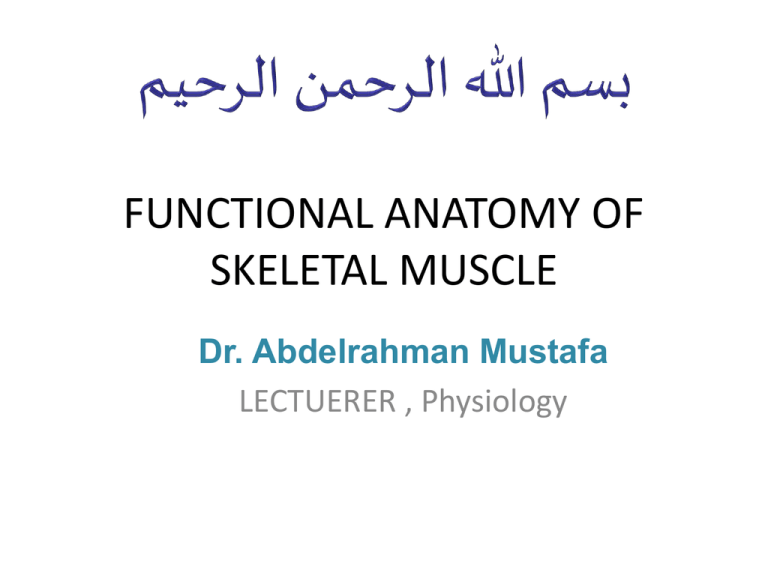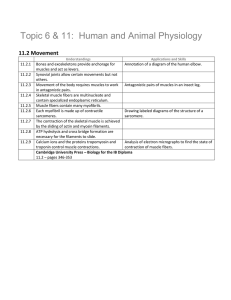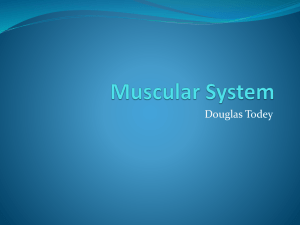functional anatomy of skeletal muscle
advertisement

FUNCTIONAL ANATOMY OF SKELETAL MUSCLE Dr. Abdelrahman Mustafa LECTUERER , Physiology Objectives By the end of this lecture, you should be able to: Draw and label a skeletal muscle at all anatomical levels. Diagram the structure of the thick and thin myofilaments and label the constituent proteins. Describe the functional importance of the subunits. Categorization of Muscle Skeletal muscle: • Striated • Under voluntary control • Lacks anatomical connection between fibers Cardiac muscle: • Striated • Under involuntary control • There are connection between fibers (gap junctions and intercalated discs) • Contracts rhythmically in the absence of external stimulation smooth muscle: • Non striated • Under involuntary control • Connections between fibers may be present or absent Muscle morphology: Skeletal muscle fibres: • Skeletal muscle is made up of muscle fibers that are building blocks of the muscular system • Most skeletal muscles begin and end tendons • Each muscle fiber is single a cell multinucleated, long ORcylindrical, and surrounded by a cell membrane, (sarcolemma) • • • • • The muscle fibers are made up of myofibrils Each myofibril consists of filaments , The filaments are : Thick filaments : myosin filaments Thin filaments : actin, tropomyosins and troponins (I, T & C) that are responsible for the actual muscle contraction Myosin • Component of thick filament • Protein molecule consisting of two identical subunits shaped somewhat like a golf club – Tail ends are intertwined around each other – Globular heads project out at one end • Tails oriented toward center of filament and globular heads protrude outward at regular intervals – Heads form cross bridges between thick and thin filaments • Cross bridge has 2 important sites critical to contractile process – An actin-binding site – A myosin ATPase (ATP-splitting) site Actin • Primary structural component of thin filaments • Spherical in shape • Thin filament also has 2 other proteins – Tropomyosin – Troponin • Each actin molecule has special binding site for attachment with myosin cross bridge – Binding results in contraction of muscle fiber Composition of a Thin Filament • Actin and myosin are often called contractile Proteins. – Neither actually contracts. • Actin and myosin are not unique to muscle cells, but are more abundant and more highly organized in muscle cells. Tropomyosin and Troponin • Often called regulatory proteins • Tropomyosin – Covers actin sites for binding with myosin , blocking interaction that leads to muscle contraction • Troponin – Made of 3 polypeptide units • One binds to tropomyosin • One binds to actin • One can bind with Ca2+ Cross-bridge interaction between actin and myosin brings about muscle contraction by means of the sliding filament mechanism. Structure of Skeletal Muscle • Sarcomere – Functional unit of skeletal muscle – Found between 2 Z lines – A band – Made up of thick filaments along with portions of thin filaments that overlap on both ends of thick filaments • H zone – Lighter area within middle of A band where thin filaments do not reach • M line – Extends vertically down middle of A band within center of H zone • I band – Consists of remaining portion of thin filaments that do not project into A band F i g u r e 3 – 3 . Sarcoplasmic Reticulum • Modified endoplasmic reticulum • Consists of fine network of interconnected compartments that surround each myofibril Transverse Tubules • T tubules • Run perpendicularly from surface of muscle cell membrane into central portions of the muscle fiber • Since membrane is continuous with surface membrane – action potential on surface membrane also spreads down into T-tubule • Spread of action potential down a T tubule triggers release of Ca2+ from sarcoplasmic reticulum into cytosol Sarcoplasm: • The spaces between the myofibrils are filled with intracellular • Containing large quantities of potassium, magnesium, phosphate and numbers of protein enzymes • Also numbers of mitochondria to supply the myofibrils with energy (ATP) References • Human physiology by Lauralee Sherwood, 7th edition • Text book physiology by Guyton &Hall,12th edition • Text book of physiology by Linda .s contanzo,third edition 24








